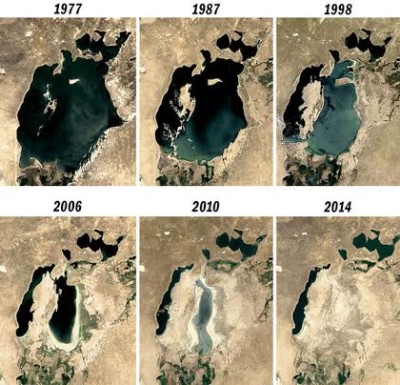Jacob MacCarter
At the 60s of last century the Aral Sea was huge lake. The Aral Sea, which has arisen in the Turan lowland, was the fourth lake in the size worldwide. The area was about 70 thousand square kilometers.
Soviet leaders decided to use rivers Amu Darya and Syr Darya, that flood the Aral Sea, to irrigate agricultural crops. The result of careless use the water of rivers was ecological crime. The Aral Sea decreased by 40 thousand square kilometers. It has lost 3/4 of the square and 60% of the water.
In 60’s of last century, soviet authorities decided to develop agriculture in the territory of Uzbekistan and Kazakhstan. Mostly, they developed cultivation of cotton and rice. To irrigate crops they were needed a lot of water. Water was taken from deltas Amu Daria and Syr Darya rivers. Sea level, the volume of water in it, decreases rapidly due to water diversion from the Amu Darya and Syr Darya rivers. Excessive water withdrawals for irrigation of agricultural land transformed the lake-sea. The big area that was rich of nature and life has become a barren desert.
Soviet Government withheld the fact of ecological deterioration on the Aral Sea. Only in 1985, Mr. Gorbachev made this ecological disaster public. At the end of the 1980s, the water level has fallen so much that the whole sea was divided into two parts: the northern Small Aral and the southern Large Aral. By 2007, in the southern part of clearly delineated deep western and eastern shallow waters as well as the remains of a small separate bay.
When the Soviet Union fell, the Aral Sea was divided into two parts between Uzbekistan and Kazakhstan. So, the huge soviet plan based on transferring water of Siberian rivers was put to an end. However, Uzbekistan and Kazakhstan started competition for the right of owning water resources. It is good that they failed to complete the project for the transfer of Siberian rivers, because nobody knows what would be the disaster after it.
Drainage water coming from the fields into the channel of the Syr Darya and Amu Darya caused deposits of pesticides and variety of other agricultural chemicals. They appeared on the 54 thousand square kilometers of the former seabed that covered with salt. Dust storms spread salt, dust and chemicals spread at a distance of 500 km. Sodium bicarbonate, sodium chloride and sodium sulfate are carry with air. It kills or slows the growth of natural vegetation and crops. The local population is suffering from respiratory diseases, anemia, cancer of the larynx and esophagus, as well as digestive disorders. People also frequently ill with kidney disease and eye diseases.
The drying up of the Aral Sea had serious consequences. Due to the sharp decrease in river flow ceased spring floods, supplied the areas of Amu Darya and Syr Darya fresh water and fertile sediments. The number of species of fish lived here decreased from 32 to 6. This is the result of increasing levels of salinity, loss of spawning and feeding areas. Shipping in the Aral Sea has stopped because water receded many kilometers from the area’s major ports.
President of Kazakhstan Nursultan Nazarbayev initiated the project “Regulation of Syr Darya and the preservation of the northern part of the Aral Sea”(“RESSAM”).In 2005, Kugoral dam with flooding sluice was built within this project. Small Aral is diking from the Big Aral now. It helps to regulate salt volume and nature diversity of the Sea.





